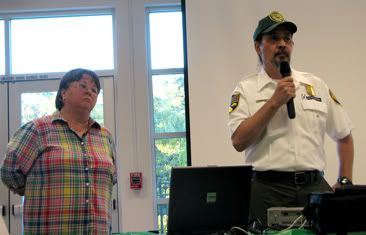
With a recent rash of coyote sightings in certain parts of Long Beach drawing concern from residents and questions from wildlife overs, Councilwoman Gerrie Schipske called a community forum last night to discuss the situation, advice, and possible solutions. Schipske described a flood of calls and concerns that have been sent to her office regarding the animals.
Joseph Torres of the California Fish and Game Department was on hand to offer expertise, and emphasized the role of the community in working to eliminate the three things that are attractive to coyotes:
Food, water and shelter.
Fifty-eight sightings have been reported in Long Beach in 2008, most in the months of June, July and August. More than half have been reported in the 90815 and 90808 zipcodes, which lie close to wetland areas that coyotes naturally frequent.
“It takes a neighborhood to try to take these things away,” he told the crowd, urging residents to start Wildlife Watch groups that act in similar nature to Neighborhood Watch. The most important thing, Torres said, is to remember not to leave out any food or water that could attract coyotes. He emphasized their intelligence and ability to scale 6-foot walls or dig underneath fences. Small pets should not be walked or left outside at night, because they are seen as prey.
Torres even went so far to advise residents to keep close watch of small children, especially at dusk or dawn, but before too much fear was spread, a member of the crowd brought up the point that incidents involving humans happen two or three times per year, and only one human fatality has occurred in the last 30 years. Torres agreed.

Councilwoman Gerrie Schipske and Joseph Torres
But the coyotes are still a nuisance, and residents want them out. They hunt family pets, dig through trash and have learned to associate humans with food. Long Beach Animal Care Services advises residents to contact them with any information about sightings, so they can document the event and track the animals. John Keisler, LBACS Business Manager, assured everyone that quick response will be on the way in the event of danger.
But the danger may be all on the coyotes’ side, and humans are at least partly to blame. California Fish and Game considers coyotes varmints, and does not relocate them, citing lack of necessary funding and the possibility of spreading diseases. Because of their status, Fish and Game destroys problem animals that were likely drawn into residential neighborhoods due to loss of habitat or plentiful food sources caused by humans.
Torres explained that feeding any wild animal Is against the law, because it begets a vicious cycle of attracting larger predators. Feeding squirrels creates a population boom, which attracts cats, which attracts coyotes. Feeding geese or other birds attracts rats (which feed on the droppings), which attract coyotes. If you eliminate their food source, Torres said, the coyotes will leave in search of easier food.
“We’ve taken the habitat away from the coyotes,” said resident Billie Sheaffer. “It’s not their fault.”
“[Urban coyotes] are a new problem in society. We’ve pushed them out–taken away the wilderness, ” said Margaux Kohut rom the crowd. Kohut suggested changing the law on relocating predatory coyotes instead of killing them or allowing them to invade the city. When told by Torres that the coyotes could introduce diseases in other locations, she responded “Diseases? All kinds of animals have diseases. Bears get relocated–why not coyotes?”
Torres urged the crowd to call him with any issues (949.337.5245).
Keisler also advised residents to visit the LBACS website (longbeach.gov/acs) to see a map of reported sightings and submit their own.
So while no clear-cut solution was found during the forum, the message relayed was one of cooperation (with Animal Care Services and CA Fish and Game), responsibility (of residents to report sightings and know what attracts the animals), and respect (of a natural predator just trying to survive).
By Ryan ZumMallen and Kate Karp
